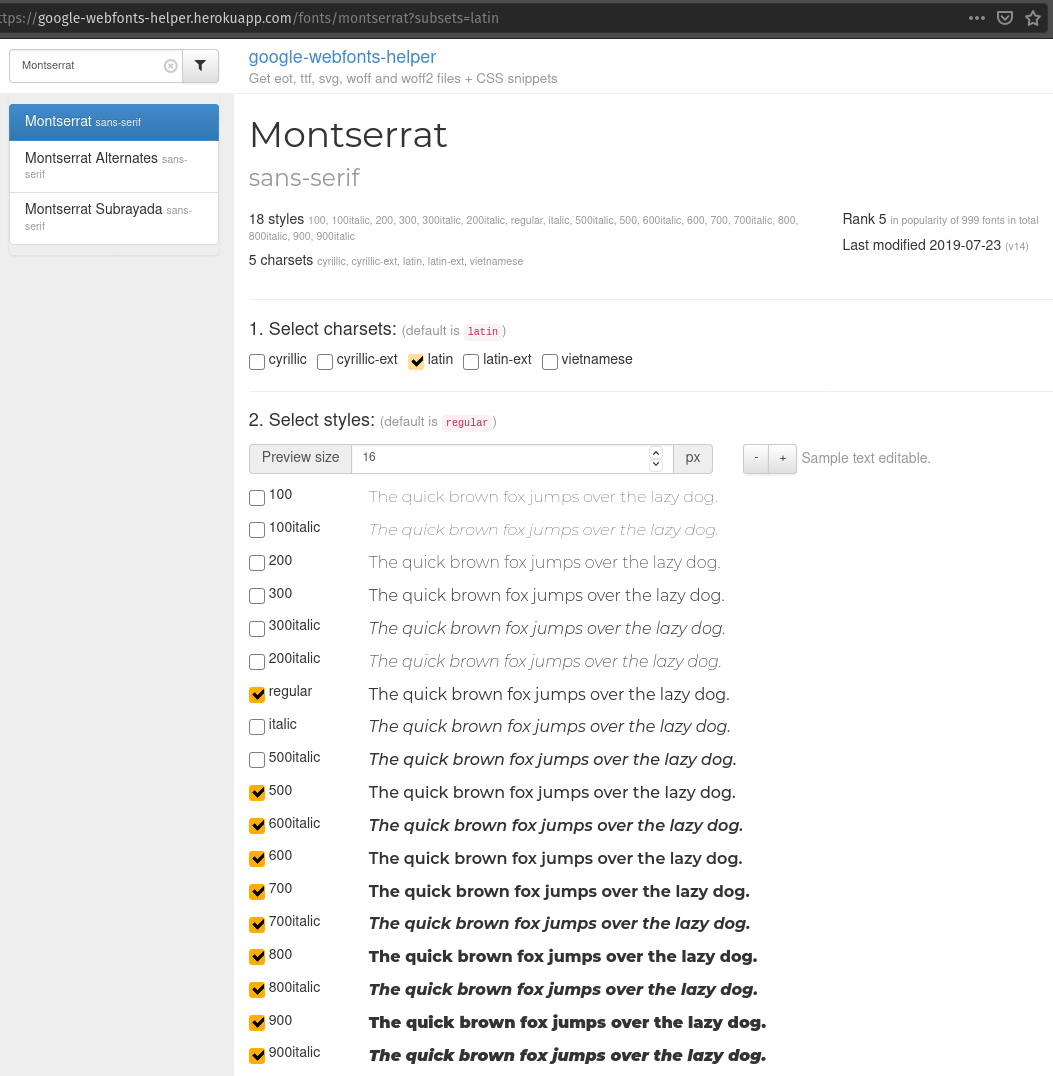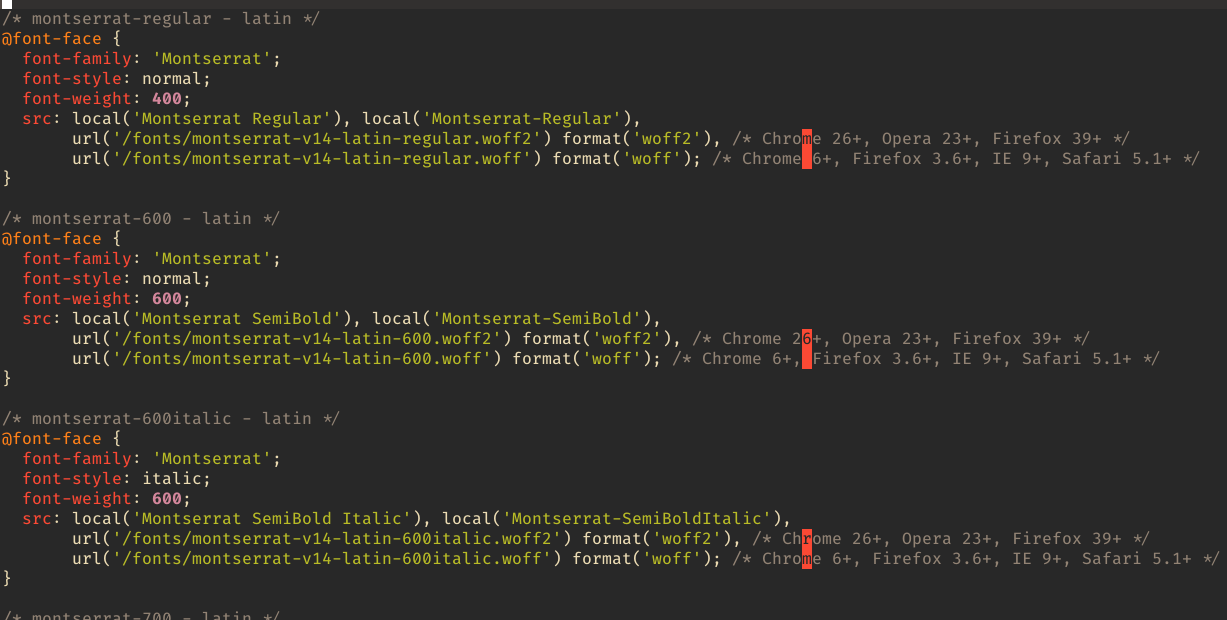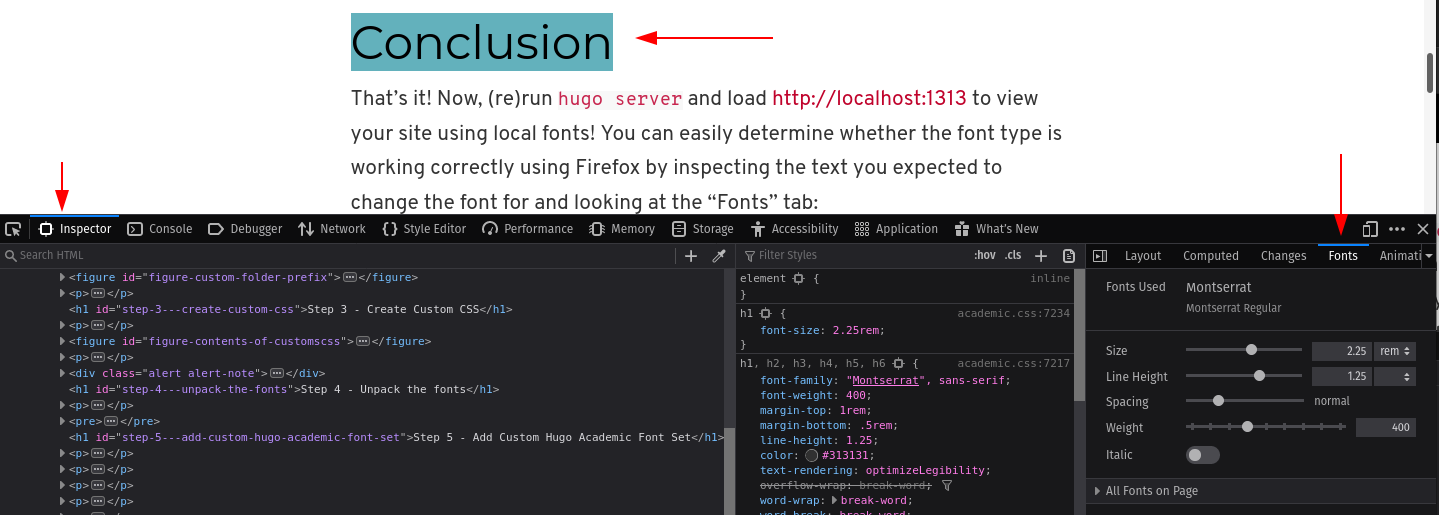The fresh new look of this site is provided by the Academic Hugo Theme. Because I value your privacy just as I value my own, I needed to modify this theme to not make use of Google Web Fonts because use of this service enables Google to further track users.
In this guide, I’ll add the Montserrat font by Julieta Ulanovsky as the heading font for this blog:
Step 1 - Select font character set and weights using Google web fonts helper
Search for Montserrat using the Google Web Fonts Helper app and select the weights desired:

Montserrat font search
Step 2 - Copy font CSS
Next, scroll down to the bottom of the “Copy CSS” section and enter /fonts/ in
the customize folder prefix textbox.

Custom folder prefix
Then, select “Modern Browsers” (or “Best Support” if you need to support ancient web browsers) and copy the CSS generated to the clipboard.
Step 3 - Create Custom CSS
Create <blogdir>/assets/scss/custom.scss and paste the CSS you just generated
with the Google web fonts helper:

Contents of custom.scss
When your blog is published, fonts will be in the https://<yoursite>/fonts/
path. You need to ensure that the font paths in your CSS statements in custom.scss
are prepended with /fonts/. See the screenshot above for examples.
If you entered /fonts/ in the customize folder prefix textbox from step 2,
this was automatically included in the CSS you copy/pasted.
Step 4 - Unpack the fonts
At the bottom of the Google web fonts helper app, there’s a button to download
the fonts you’ve selected. Do so and extract them to <blogdir>/static/fonts,
creating this folder if it does not exist. For instance, the font directory for
this blog looks something like this:
blog/static/fonts
├── montserrat-v14-latin-600italic.woff
├── montserrat-v14-latin-600italic.woff2
├── montserrat-v14-latin-600.woff
├── montserrat-v14-latin-600.woff2
├── montserrat-v14-latin-700italic.woff
├── montserrat-v14-latin-700italic.woff2
├── montserrat-v14-latin-700.woff
├── montserrat-v14-latin-700.woff2
Step 5 - Custom Font Set
The documentation describes the next step: customizing the Hugo
Academic font set by copying <blogdir>/themes/academic/data/fonts/minimal.toml
to <blogdir>/data/fonts/default.toml. (Note: I chose the name default.toml
arbitrarily, you could name this whatever you’d like so long as there aren’t
spaces in the filename)
Open this file and change the font name to “Default” (or whatever you named
your font file - if you named it my_fonts.toml your font name would be
my-fonts).
Next, set google_fonts to an empty string or comment it out altogether to
prevent Academic from calling out to Google web fonts.
Finally, change the font families as desired using the name of the font defined
in custom.scss. Since I want my heading font to be Montserrat, I set the
following:
# Font style metadata
name = "Default"
# Optional Google font URL
google_fonts = ""
# Font families
heading_font = "Montserrat"
body_font = "Overpass"
nav_font = "Overpass"
mono_font = "Overpass Mono"
Step 6 - Override the Hugo Academic Font
The last step is to tell Academic to use your custom font. I named my font set
Default and defined it in <blogdir>/data/fonts/default.toml. Therefore, in
my <blogdir>/config/_default/params.toml file, I set font = "Default"
That’s it! Now, (re)run hugo server and load
http://localhost:1313 to view your site using local
fonts! You can easily determine whether the font type is working correctly using
Firefox by inspecting the text you expected to change the font for and looking
at the “Fonts” tab:

Font inspection in Firefox
Recap
At the start of this post, I wanted to use the Montserrat font for my headings. Here’s what the configuration looks like:
Font
Font files were placed in <blogdir>/static/fonts:
blog/static/fonts
├── montserrat-v14-latin-600italic.woff
├── montserrat-v14-latin-600italic.woff2
├── montserrat-v14-latin-600.woff
├── montserrat-v14-latin-600.woff2
├── montserrat-v14-latin-700italic.woff
├── montserrat-v14-latin-700italic.woff2
├── montserrat-v14-latin-700.woff
├── montserrat-v14-latin-700.woff2
├── montserrat-v14-latin-800italic.woff
├── montserrat-v14-latin-800italic.woff2
├── montserrat-v14-latin-800.woff
├── montserrat-v14-latin-800.woff2
├── montserrat-v14-latin-900italic.woff
├── montserrat-v14-latin-900italic.woff2
├── montserrat-v14-latin-900.woff
├── montserrat-v14-latin-900.woff2
├── montserrat-v14-latin-regular.woff
├── montserrat-v14-latin-regular.woff2
Custom CSS
I pasted the CSS output from the Google web font helper into
<blogdir>/assets/scss/custom.scss:
/* montserrat-regular - latin */
@font-face {
font-family: 'Montserrat';
font-style: normal;
font-weight: 400;
src: local('Montserrat Regular'), local('Montserrat-Regular'),
url('/fonts/montserrat-v14-latin-regular.woff2') format('woff2'), /* Chrome 26+, Opera 23+, Firefox 39+ */
url('/fonts/montserrat-v14-latin-regular.woff') format('woff'); /* Chrome 6+, Firefox 3.6+, IE 9+, Safari 5.1+ */
}
/* montserrat-600 - latin */
@font-face {
font-family: 'Montserrat';
font-style: normal;
font-weight: 600;
src: local('Montserrat SemiBold'), local('Montserrat-SemiBold'),
url('/fonts/montserrat-v14-latin-600.woff2') format('woff2'), /* Chrome 26+, Opera 23+, Firefox 39+ */
url('/fonts/montserrat-v14-latin-600.woff') format('woff'); /* Chrome 6+, Firefox 3.6+, IE 9+, Safari 5.1+ */
}
/* montserrat-600italic - latin */
@font-face {
font-family: 'Montserrat';
font-style: italic;
font-weight: 600;
src: local('Montserrat SemiBold Italic'), local('Montserrat-SemiBoldItalic'),
url('/fonts/montserrat-v14-latin-600italic.woff2') format('woff2'), /* Chrome 26+, Opera 23+, Firefox 39+ */
url('/fonts/montserrat-v14-latin-600italic.woff') format('woff'); /* Chrome 6+, Firefox 3.6+, IE 9+, Safari 5.1+ */
}
/* montserrat-700 - latin */
@font-face {
font-family: 'Montserrat';
font-style: normal;
font-weight: 700;
src: local('Montserrat Bold'), local('Montserrat-Bold'),
url('/fonts/montserrat-v14-latin-700.woff2') format('woff2'), /* Chrome 26+, Opera 23+, Firefox 39+ */
url('/fonts/montserrat-v14-latin-700.woff') format('woff'); /* Chrome 6+, Firefox 3.6+, IE 9+, Safari 5.1+ */
}
/* montserrat-700italic - latin */
@font-face {
font-family: 'Montserrat';
font-style: italic;
font-weight: 700;
src: local('Montserrat Bold Italic'), local('Montserrat-BoldItalic'),
url('/fonts/montserrat-v14-latin-700italic.woff2') format('woff2'), /* Chrome 26+, Opera 23+, Firefox 39+ */
url('/fonts/montserrat-v14-latin-700italic.woff') format('woff'); /* Chrome 6+, Firefox 3.6+, IE 9+, Safari 5.1+ */
}
/* montserrat-800 - latin */
@font-face {
font-family: 'Montserrat';
font-style: normal;
font-weight: 800;
src: local('Montserrat ExtraBold'), local('Montserrat-ExtraBold'),
url('/fonts/montserrat-v14-latin-800.woff2') format('woff2'), /* Chrome 26+, Opera 23+, Firefox 39+ */
url('/fonts/montserrat-v14-latin-800.woff') format('woff'); /* Chrome 6+, Firefox 3.6+, IE 9+, Safari 5.1+ */
}
/* montserrat-800italic - latin */
@font-face {
font-family: 'Montserrat';
font-style: italic;
font-weight: 800;
src: local('Montserrat ExtraBold Italic'), local('Montserrat-ExtraBoldItalic'),
url('/fonts/montserrat-v14-latin-800italic.woff2') format('woff2'), /* Chrome 26+, Opera 23+, Firefox 39+ */
url('/fonts/montserrat-v14-latin-800italic.woff') format('woff'); /* Chrome 6+, Firefox 3.6+, IE 9+, Safari 5.1+ */
}
/* montserrat-900 - latin */
@font-face {
font-family: 'Montserrat';
font-style: normal;
font-weight: 900;
src: local('Montserrat Black'), local('Montserrat-Black'),
url('/fonts/montserrat-v14-latin-900.woff2') format('woff2'), /* Chrome 26+, Opera 23+, Firefox 39+ */
url('/fonts/montserrat-v14-latin-900.woff') format('woff'); /* Chrome 6+, Firefox 3.6+, IE 9+, Safari 5.1+ */
}
/* montserrat-900italic - latin */
@font-face {
font-family: 'Montserrat';
font-style: italic;
font-weight: 900;
src: local('Montserrat Black Italic'), local('Montserrat-BlackItalic'),
url('/fonts/montserrat-v14-latin-900italic.woff2') format('woff2'), /* Chrome 26+, Opera 23+, Firefox 39+ */
url('/fonts/montserrat-v14-latin-900italic.woff') format('woff'); /* Chrome 6+, Firefox 3.6+, IE 9+, Safari 5.1+ */
}
Font Set
<blogdir>/data/fonts/default.toml:
# Font style metadata
name = "Default"
# Optional Google font URL
google_fonts = ""
# Font families
heading_font = "Montserrat"
body_font = "Overpass"
nav_font = "Overpass"
mono_font = "Overpass Mono"
Font Override in Academic Config
<blogdir>/config/_default/params.toml:
...
# Enable users to switch between day and night mode?
day_night = true
# Override the theme's font set (optional).
# Latest font sets (may require updating): https://sourcethemes.com/academic/themes/
# Browse built-in font sets in `themes/academic/data/fonts/`
# Browse user installed font sets in `data/fonts/`
font = "Default"
# Choose a font size.
# Sizes: XS (extra small), S (small), M (medium), L (large - DEFAULT), XL (extra large)
font_size = "L"
...
Conclusion
Using local fonts in your Hugo Academic theme will improve your visitors' privacy and might even speed up your page load times!